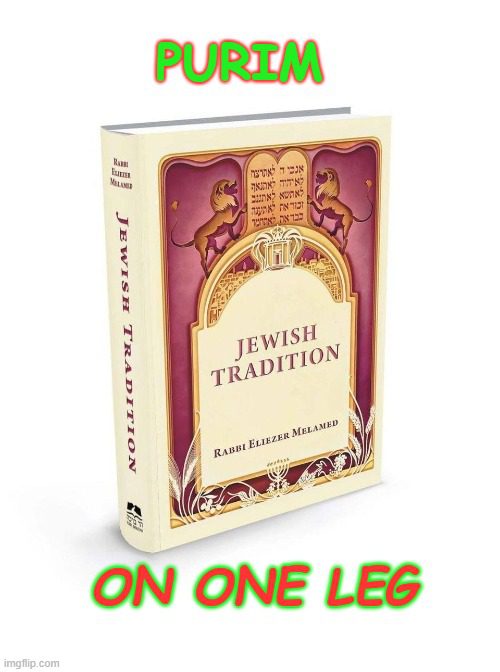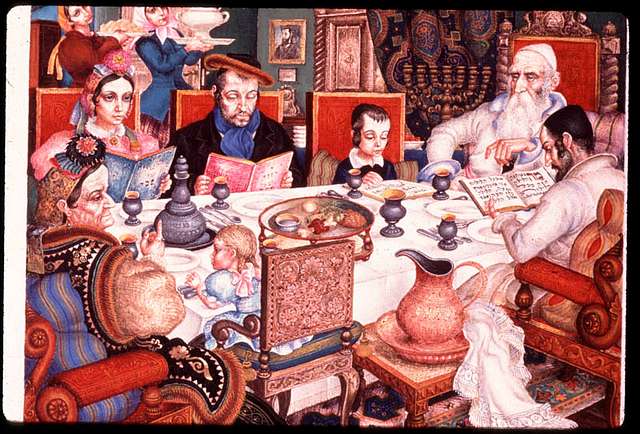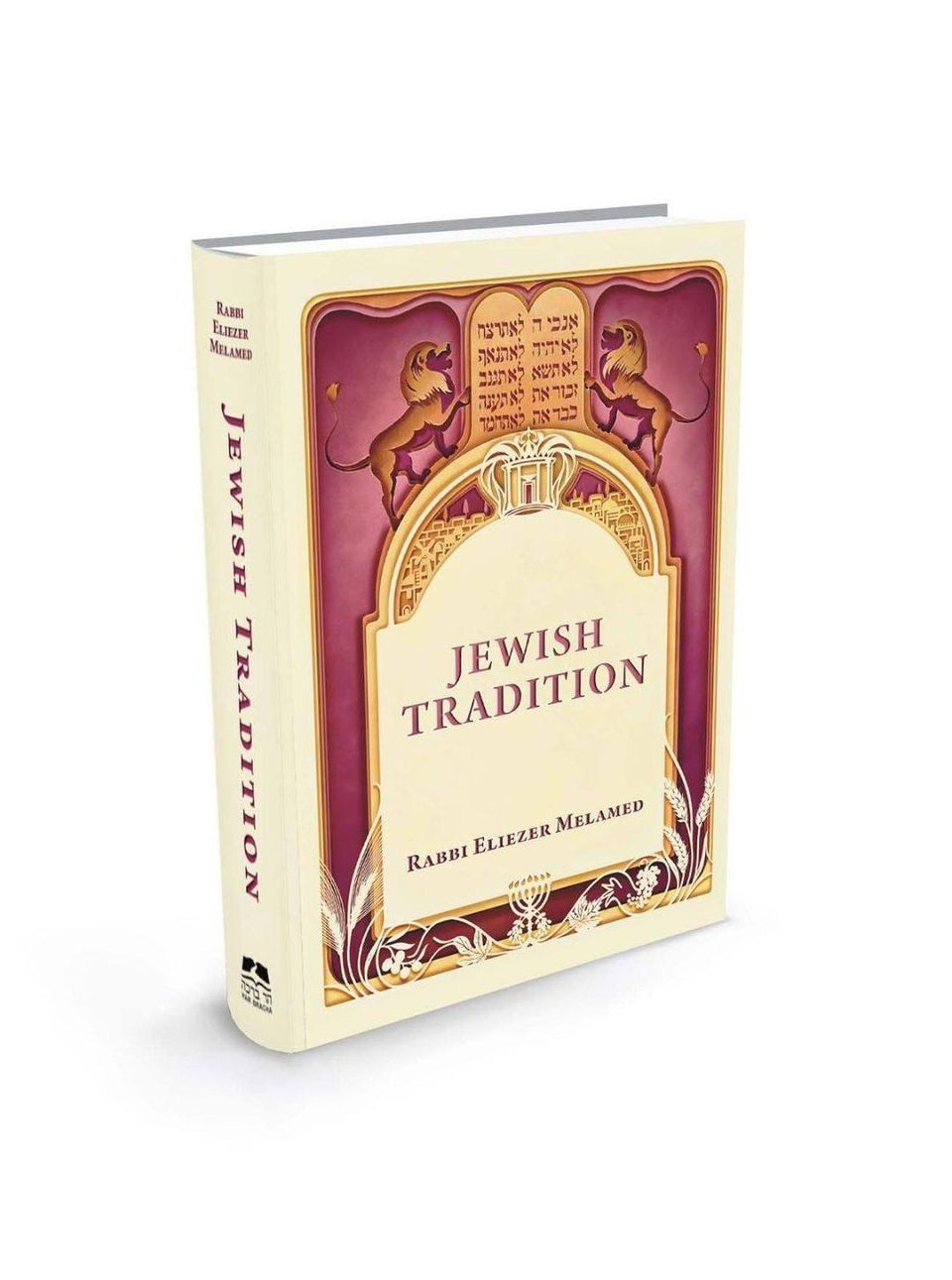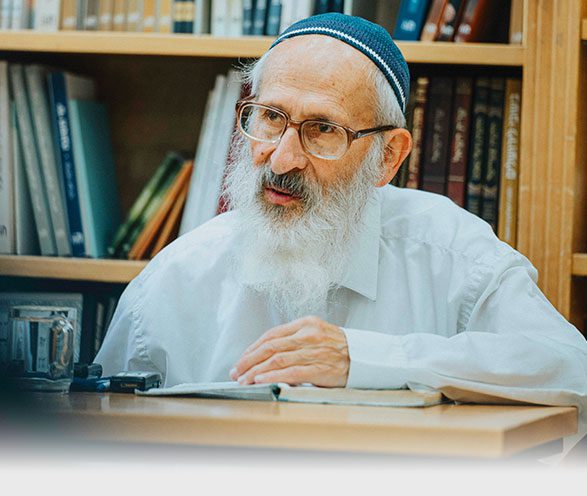Purim
by HaRav Eliezer Melamed, Rabbi of the Har Bracha community and Head of Yeshiva Har Bracha. Taken from his book “Jewish Tradition” Chapter 39.
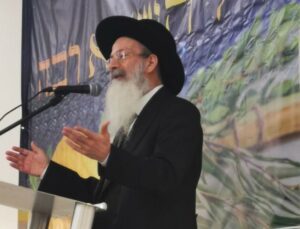
- Increasing Joy in Adar
We usually feel happy about the good things in life, but because life also includes evil and pain, this joy is not complete. However, when we understand that even the bad is ultimately transformed into good, this can make us feel especially joyful. This is exactly what happened in the month of Adar, on Purim: God transformed bad into good and saved His people. (See section 5 below.) This teaches us that everything that happens in the world – even terrible things – will eventually be transformed for the better. The greater our faith in God and our commitment to the Torah, the closer we bring the ultimate redemption, when all bad will be transformed into good, and the world will become a much happier place. Since the month of Adar has the unique ability to transform bad into good, the Sages proclaimed: “When Adar arrives, we increase joy.”
In a leap year, there are two months of Adar, which we call Adar Rishon (or Adar Aleph, the first Adar) and Adar Sheni (or Adar Bet, the second Adar). Purim is celebrated during the second Adar, to juxtapose the redemption of Purim with the redemption from Egypt (since Passover is in Nissan, the following month). However, even the first Adar has a celebratory aspect to it, and we increase our joy then as well.
- Practices of Adar
The Sages instituted the public reading of four Torah passages (parshiyot) to follow the weekly Torah portion:
Parashat Shekalim (Exodus 30:11-16) is usually read on the Shabbat before Adar. It was originally instituted to remind everyone to contribute a half-shekel, used to purchase communal offerings in the Temple. Today, there is a custom to give charity during Adar to commemorate this yearly donation.
Parashat Zakhor (Deuteronomy 25:17-19) is read on the Shabbat before Purim. We thus fulfill the Torah commandment to remember what the Amalekites did to us. (See the following section.)
Parashat Para (Numbers 19:1-22) is read on the Shabbat before Parashat Ha-ĥodesh, as the month of Nissan approaches. (See the next paragraph.) It was originally instituted to remind people to purify themselves in preparation for the ascent to Jerusalem to celebrate Passover during Temple times.
Parashat Ha-ĥodesh (Exodus 12:1-20) is read on the Shabbat before Nissan, to remind us to start preparing for Pesaĥ.
The universal Jewish custom is to fast on the thirteenth of Adar. Ta’anit Esther (Esther’s Fast) is to commemorate the fasts Queen Esther undertook before approaching King Ahasuerus to ask him to annul the decree against the Jewish people (Esther 4:16). It also commemorates the fast the Jews undertook on the thirteenth of Adar of that year. Since we are still plagued by enemies who want to wipe us out, fasting and repenting are still necessary. The laws pertaining to Ta’anit Esther are more lenient than those of the minor fasts commemorating the destruction of the Temple (37:6 above). One who is weak or might be sick is not required to fast.
- Wiping Out Amalek
The biblical requirement to remember the abominable actions of the Amalekite nation is fulfilled by reading Parashat Zakhor, which includes the incident and the injunction. The Sages instituted it be read on the Shabbat before Purim. They associated the mitzva with Purim, as Haman the Agagite and many of his co-conspirators were of Amalekite descent.
There are three Torah commandments relating to Amalek:
- Remember what Amalek did to us.
- Do not forget what Amalek did to us.
- Wipe out Amalek’s descendants.
The Jewish nation has a challenging role in the world. The message of ideals and faith God wishes us to convey to the world provokes the wicked against us. This persecution began with the Amalekites, and it is why no nation has been more persecuted throughout history than the Jews.
Instead of developing agriculture or industry, the Amalekites supported themselves by stealing and looting. Living on the edges of the desert, they would periodically attack encampments, plundering, murdering, and selling the rest of the inhabitants – women and children too – into slavery. They tried to do this to the Israelites immediately after the Exodus. By nature, Jews are merciful and kind, and many mitzvot in the Torah cultivate these traits. Therefore, the Jews are naturally inclined to forgive the Amalekites for their attack. However, God commands us to remember the Amalekites’ evil and wipe them out. This ensures we remain aware of the existence of evil in the world, and the necessity to fight it. Only afterwards can we repair the world.
Nevertheless, an Amalekite who agrees to observe the seven Noahide laws (2:4 above) no longer has the status of an Amalekite, and may not be killed. Moreover, we are obligated to offer Amalekites peace before waging war against them. We give them the opportunity to abandon murder and robbery and accept the seven Noahide laws (17:22 above).
Halakhic authorities debate whether an Amalekite who wants to convert to Judaism may be accepted. However, all agree an Amalekite who assimilated into another nation no longer has the status of an Amalekite, and those descendants may convert. Accordingly, even though Haman was of Amalekite stock, the Sages state his descendants taught Torah in Bnei Brak.
- Wiping Out Amalek (in Practice)
The mitzva to wipe out the nation of Amalek is primarily incumbent upon the Jewish people as a whole. According to the Sages, the Jewish people were commanded to fulfill three mitzvot upon entering the Land of Israel: appoint a king, wipe out the descendants of Amalek, and build the Holy Temple.
Once the Jews established themselves in the Land with Saul as their king, the prophet Samuel commanded them to destroy the nation of Amalek. Unfortunately, King Saul did not fulfill the mitzva properly. In his war with the Amalekites, he did not chase down all their regiments, and having pity on King Agag, he spared him (as well as the best of the sheep and cattle). As a result, God took the kingdom away from Saul and gave it to David. Nevertheless, devastating damage had been done. Because of Saul’s misplaced compassion, many Amalekites survived and continued harassing the Jews. In fact, there is a tradition that Haman, who wished “to destroy, massacre, and exterminate all the Jews” (Esther 3:13), descended from those very Amalekites.
Today, nobody knows who is descended from Amalek. No one traces their lineage to the Amalekites, or vows to continue in their ways. However, the mitzvot to remember and not forget what Amalek did to us remain in force, as does the mitzva to wipe out Amalek, in the sense of waging an all-out war against bloodthirsty societies that dedicate themselves to murder and terror.
- The Purim Miracle
The miracle we celebrate on Purim took place during a very vulnerable time in Jewish history. Approximately seventy years earlier, the Babylonians had destroyed the First Temple, and exiled the Jewish people from their Land. In the meantime, the Persian Empire arose, deposed the Babylonian Empire, and ruled all the countries in the area. Cyrus, the great Persian king, issued an edict permitting the Jews to return to their Land and rebuild the Temple. Regrettably, only a small minority actually did so. Due to the small numbers of Jews, their opponents were able to cause trouble and convince the Persian king to stop the rebuilding. Meanwhile, the large Jewish population who lived throughout the Persian Empire were assimilating and copying the gentiles’ behavior. It seemed as though the great vision the Jewish people were meant to spread was fading away. There would no longer be hope for a return to Zion, and the Jewish people would not bring God’s word to the world.
In heaven, a great accusation was leveled against the Jews: God chose them from all the other nations, gave them His Torah, and manifested the Divine Presence in their midst, yet they were acting like the gentiles, bowing to idols, and neglecting to return to their Land to build the Holy Temple! At the same time, Haman, Amalek’s wicked descendant, rose to prominence in Persia. His hatred led the Persian Empire to enact a decree which would allow antisemites “to destroy, massacre, and exterminate all the Jews, young and old, children and women, on a single day, the thirteenth of the twelfth month (the month of Adar), and to plunder their possessions” (Esther 3:13).
Ultimately, it became clear God had provided the solution to the problem in advance. About five years earlier, after Ahasuerus had killed Queen Vashti, his wife, his minions started gathering virgins from all the nations of the Empire, so the king could choose one as his new wife. Esther, a Jewish orphan adopted by Mordecai, her cousin, was among those young women. Following Mordecai’s guidance, Esther kept her Jewish identity secret. The king chose her as his queen. Later, with the edict to exterminate the Jews, Mordecai requested that Esther risk her life on behalf of her people. Despite the danger, she found a way to foil wicked Haman’s plans. Esther revealed to the king that Haman was planning to exterminate her people. Ahasuerus was also informed that Haman, who was jealous of Mordecai, had prepared a tall tree, upon which he was planning to hang Mordecai. Mordecai had earlier proved his loyalty to the king by exposing a plot against the king’s life. So, Ahasuerus ordered that Haman be hung on the very same tree he had prepared for Mordecai. The king also appointed Mordecai to Haman’s position of prime minister. Finally, the Jews were given permission to defend themselves and kill the enemies scheming to kill them. In a tremendous reversal, the Jews killed their enemies instead of being killed by them. (This was made easier since their enemies were already frightened because Haman had been hanged and Mordecai had ascended to power.) The nations gained a new respect for the Jews. All this is described in Megillat Esther (the Book of Esther).
Let us analyze this in depth. According to tradition, Haman’s evil edict was the Jews’ wake-up call. They renewed their faith and devotion to God, repented, and increased their prayer and Torah study. They were inspired to return to and settle the Land of Israel, and build the Second Temple. The door was opened to a quantum leap in the study of the Oral Torah, the main spiritual accomplishment of the Second Temple era.
The Purim story thus expresses the Jewish people’s eternal sanctity. Even though our unique spiritual capacity is sometimes concealed by our sins, it never disappears. God directs the world so it is eventually revealed again.
- Walled and Unwalled Cities
A unique halakha pertaining to Purim is that it has two dates. To understand the reason for this distinction, we must first recall the order of events. Haman’s edict stated that all the antisemites would be permitted to kill the Jews on the thirteenth of Adar. With Mordecai and Esther’s ascension to power, the edict was modified to permit the Jews to defend themselves and kill their enemies. They did so on the thirteenth of Adar. On the next day, the fourteenth of Adar, they celebrated. However, in Shushan the capital, there were so many antisemites the Jews were granted an extra day to fight back. Therefore, in Shushan, their victory celebration took place on the fifteenth of Adar.
To commemorate the two days of celebration, the Sages ruled that Purim should be celebrated on the fifteenth in all important cities surrounded by walls, like the capital city of Shushan, and on the fourteenth everywhere else. At the time of the Purim story, the Land of Israel was desolate and had no walled cities. Nevertheless, to honor the Land of Israel, the Sages decided that cities walled at the time of Joshua son of Nun would celebrate Purim on the fifteenth.
In the 2500 years that have passed since then, traditions have been lost about which places had walls at that time, and some cities’ status is doubtful. There is only one city for which we still have a clear tradition as to its walled status during the times of Joshua – Jerusalem, our holy and glorious city. Only there does everyone celebrate Purim on the fifteenth. Cities whose status is unclear (such as Hebron, Tiberias, Jaffa, and Lod) celebrate Purim on the fourteenth. Residents of those cities who wish to enhance the mitzva celebrate both days.[1]
- The Mitzvot of Purim
To commemorate the miracle, the Men of the Great Assembly (the High Court at the beginning of the Second Temple era) established Purim as a holiday for all time. There are four mitzvot on Purim, all of which we will explain below:
- Reading Megillat Esther
- Having a festive meal and rejoicing
- Sending mishlo’aĥ manot (food packages)
- Giving matanot la-evyonim (charity to the poor)
Three of these mitzvot are mentioned explicitly in Esther 9:22: “Observe them as days of feasting and joy, sending portions (mishlo’aĥ manot) to one another, and gifts to the poor (matanot la-evyonim).”
It is customary to wear holiday clothing on Purim. Taking off from work is preferable, but working is permitted to avoid significant loss, or to buy Purim necessities).
Al Ha-nisim is recited in the Amida and in the Grace After Meals.
- Reading the Megilla
There is a mitzva for every Jew to read Megillat Esther aloud (or to listen to it being read) twice on Purim: once at night, and once by day. The goal of the reading is to publicize the miracle, as the Megilla’s story demonstrates how God supervises the world, guiding everything in a positive direction. Even the worst tragedies, such as the genocide planned by Haman, can ultimately be transformed. Three blessings are recited before reading the Megilla: “Blessed are You, Lord our God, King of the Universe, Who has sanctified us with His mitzvot and commanded us concerning the reading of the Megilla”; “Blessed are You, Lord our God, King of the Universe, Who performed miracles for our ancestors in those days, at this time”; and “Blessed are You, Lord our God, King of the universe, Who has given us life (She-heĥeyanu), sustained us, and brought us to this time.” After the reading, it is customary to recite Ha-rav et Rivenu, a blessing of thanks and praise.
It is preferable to read the Megilla in a large group. Minimally, there should be a minyan. If this is not possible, the Megilla may be read even without a minyan.
One should read from a scroll written in ink on parchment. If the reader skipped a word or made a mistake which changed the meaning of the word, the reader must go back to the point where the mistake was made. A person listening to the Megilla must hear every word. If even one word is missed, the listener has not fulfilled the obligation. To avoid this problem, people generally follow the reading in their own copy of the Megilla. This way, if they miss hearing a word, they can read it themselves.
Once children are old enough to understand the Megilla and sit quietly to listen to it, they should be brought to the Megilla reading. Typically, this is around age nine. It is a good idea to bring younger children as well, if they will not be disruptive.
During the Middle Ages, primarily in Ashkenazic countries, a custom began among children – and even adults – to make noise when Haman’s name is read in the Megilla. Perhaps they viewed Haman as a stand-in for the antisemites who made them suffer. Today, some do not follow this custom, and some even oppose it because the noise makes it difficult to listen to the Megilla with the proper concentration. Nevertheless, it remains the standard custom, and is permitted as long as everyone can hear the entire Megilla properly.
- Joy and Kindness
Haman’s edict would have destroyed us completely, body and soul; accordingly, our joy at being saved should be both spiritual and physical. Our spiritual side is expressed in the mitzva of reading the Megilla. Our physical side is expressed in the mitzva to have a festive and joyous meal (sections 10-12 below). This joy must also include fostering a sense of love and unity among the Jewish people, accomplished by sending food packages to each other, and giving money to the poor (sections 14-16 below). This is true happiness, the result of expanding our mindset to encompass a love of humanity, which extends to including the poor in our celebration. Furthermore, Purim’s special character is expressed in Jewish unity. Haman’s edict was against the entire Jewish people. He did not distinguish between the righteous and the wicked, the rich and the poor. Accordingly, Purim happiness should include everyone as well.
- Rejoicing, Eating, and Drinking
Throughout Purim (night and day) there is a mitzva to be very joyful. Whatever increases one’s happiness enhances this mitzva. However, the primary expression of the mitzva is to have a festive meal (on Purim day), during which wine and other alcoholic beverages are enjoyed. It is preferable to have the meal with family or friends to make it more pleasurable.
The mitzva of joy on Purim is unique. There is a mitzva to rejoice on other holidays too (as Deuteronomy 16:14 puts it, “You shall rejoice in your festival”). That rejoicing does include drinking wine (as it makes most people happy). However, there is no mitzva to drink in large amounts. Yet, Purim’s joy is explicitly about drinking. In the phrase “feasting and joy,” the Hebrew for “feasting” is mishteh, the root of which means “to drink.” Our Sages go so far as to state that “A person is obligated to drink on Purim until he does not know the difference between ‘cursed be Haman’ and ‘blessed be Mordecai’” (Megilla 7b).
- How Much to Drink
There are two primary understandings of the mitzva to drink. Some say it means we should drink more than our norm, becoming happy and tipsy. However, we should not get so drunk that we are likely to behave in an undignified manner. Others maintain the mitzva is truly to get drunk, even if the result is undignified and perhaps even somewhat embarrassing. However, if one feels one might embarrass oneself greatly or transgress any halakhic prohibition, one should not get drunk. In practice, people need to choose for themselves the way that will best allow them to drink and rejoice for the sake of heaven.
Women also have a mitzva to rejoice and so they too should drink more happiness-inducing wine than their norm. However, they should not get drunk, as getting drunk is more degrading for women than for men.
- Why Drink
As a rule, drunkenness is disgraceful and liable to lead to trouble, as is clear throughout biblical and rabbinic literature. However, we cannot ignore the positive aspects of drinking, as it can cheer people up and help them relax.
On Purim in particular, when a miraculous salvation came about through events that involved drinking (Ahasuerus’ drink-laden feasts), it is appropriate to give expression to drinking’s positive aspects. Additionally, on Purim, it becomes clear that everything God does to the Jewish people is for the best. Even terrible edicts can ultimately benefit us. When we have this complete faith, boundless joy permeates all aspects of our lives.
- Wearing Costumes
Many people customarily wear masks and costumes on Purim. Even though there is no source for this in the writings of the Sages, many explanations have been offered for the custom. Here are a few of them:
First, dressing up in costume can be entertaining and make people laugh. Additionally, when people dress differently from their norm, it allows them to relax, be happy, and express their love for their friends. Furthermore, in general, the fact everyone dresses differently serves to separate people. Changing our external appearance on Purim breaks down the barriers between us and increases unity. Finally, by wearing costumes, we become aware of the degree to which we are influenced by external elements. As a result, we can focus more on the internal elements, revealed on Purim.
- Matanot La-evyonim
One of the mitzvot of Purim day is for each and every Jew to give matanot la-evyonim, gifts to the poor. To fulfill this mitzva, a minimum of two gifts must be given – one each to two poor people. But the more matanot la-evyonim one gives, the better.
The gift should be something which can be enjoyed at the festive meal – either a simple meal’s worth of food, or money to buy such a meal. (It is not acceptable to give clothes or books.) While the gift must be something that can contribute to the meal, the poor person may do with the gift as he or she pleases.
For this mitzva, a poor person is defined as someone who does not have enough money to meet the family’s essential needs, as understood by the time and place in which they live. The two gifts may be given to a poor couple. Similarly, they may be given to a widow and her young dependent son. However, the two gifts should not be given to the same poor person. Those who do not know two poor people, or are embarrassed to give them the gift, should give the gifts to a reputable administrator of charity funds who will distribute them on their behalf. Many follow this practice.
- Mishlo’aĥ Manot
Another mitzva of Purim day is for each and every Jew to send two portions of food to someone else. This is called mishlo’aĥ manot (or shalaĥ manos in Yiddish). The purpose is to increase good feeling, which naturally happens when someone eats good, tasty food received from a friend. The more people one gives mishlo’aĥ manot to, the better.
Two different food items must be given. For example, bread and meat, fish and eggs, or cake and apples. Two types of cake may be sent, or two portions of meat with different flavors (such as cooked meat and roasted meat). A bottle of a noteworthy drink, such as wine, beer, or juice, is considered a portion of food for this purpose. Each portion should consist of a respectable amount of food which could be served to a guest. For example, a single grape is not a large enough portion with which to honor a guest. Therefore, a person who wants grapes to be one of the two portions, needs to include a reasonable amount.
- Comparing Mishlo’aĥ Manot and Matanot La-evyonim
As mentioned above, mishlo’aĥ manot and matanot la-evyonim must be given on Purim day. One who gives them at night does not fulfill the obligation. One who fails to locate anyone poor on Purim day should set aside the money until two appropriate recipients are found. Mishlo’aĥ manot must be given specifically on Purim, when there is a special mitzva to increase good feeling among friends.
Those who are worried they might not locate poor people on Purim, may deposit money with the administrator of a charity fund before Purim, with instructions to hand it out on Purim on their behalf. Similarly, those unable to distribute mishlo’aĥ manot on Purim day can appoint an agent to distribute on their behalf. If they did not do this in advance, they should call a friend on Purim and ask that person to give mishlo’aĥ manot to someone on their behalf.
Since the purpose of mishlo’aĥ manot is to increase good feeling among people, they may not be given anonymously. In contrast, the mitzva of matanot la-evyonim is similar to charity, whose goal is to help the poor in the best possible way. Therefore, it is preferable to give matanot la-evyonim anonymously or through a charity administrator, to avoid embarrassing the recipients.
- Purim Inspiration All Year Long
Since we celebrate Purim only one day a year, and we cannot send out an infinite number of mishlo’aĥ manot or participate in a festive meal with every single one of our friends and relatives, questions arise. To whom is it best to send mishlo’aĥ manot? To our closest circle of friends who always stand by us, or to those more distant, with whom relations may be a bit more tense? Is it better to send mishlo’aĥ manot to a couple of friends, or is it better to send to ten, twenty, or thirty people? Similar questions arise when it comes to the festive meal. Is it better to have it with family (of one side or the other), or with good friends, or with new immigrants? Should there be twenty participants or fifty? The answers to these questions are that all options are reasonable.
Thinking about these issues on Purim can inspire us throughout the year. On Purim, we will not be able to give mishlo’aĥ manot to everyone. But it can help us understand the beauty of giving food, so we will think about sending food to family and friends any time of year. For example, if we are baking challahs or cooking something special for Shabbat, we can increase the quantities. We can send some of it to a friend who had a busy week, to someone who just celebrated a birthday, someone who started a new job, or someone fired from an old one. This allows us to extend the closeness created on Purim to the rest of the year.
This is also true for the festive meal. On Purim, we can eat with only a minority of our friends and family, but the joy of this meal can help us understand the value of celebrating with them. This understanding will lead us to make the effort to participate in our friends’ and relatives’ weddings, circumcisions, and other social celebrations.
This is also true for matanot la-evyonim. Giving to the poor on Purim will hopefully encourage us to be generous throughout the year, giving a tenth or even a fifth of our income to charity (6:12 above).
Finally, reading the Megilla on Purim can help us throughout the year. If we internalize its messages (section 5 above), we can better understand how God runs the world, and be inspired to study more Torah all year long.
[1] In some years, when the fifteenth of Adar is on Shabbat, Jerusalem experiences an unusual Purim. It is called Purim Meshulash (“Triple Purim”) because the mitzvot of Purim are divided over three days. On Friday, we read the Megilla and give matanot la-evyonim. On Shabbat, we recite Al Ha-nisim and the Torah reading includes the passage normally read on Purim. On Sunday, we eat the festive meal and give mishlo’aĥ manot.

